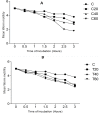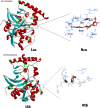Anthelmintic Potential of Thymoquinone and Curcumin on Fasciola gigantica
- PMID: 28152102
- PMCID: PMC5289557
- DOI: 10.1371/journal.pone.0171267
Anthelmintic Potential of Thymoquinone and Curcumin on Fasciola gigantica
Abstract
Fasciolosis an economically important global disease of ruminants in the temperate and tropical regions, caused by Fasciola hepatica and F. gigantica, respectively, also poses a potential zoonotic threat. In India alone it causes huge losses to stakeholders. Anthelmintics including triclabendazole have been used to control this menace but the emerging resistance against the available compounds necessitates identification of novel and alternative therapeutic measures involving plant derived natural compounds for their anthelmintic potential. Thymoquinone (T) and curcumin (C), the active ingredients of Nigella sativa and Curcuma longa respectively have been used as antiparasitic agents but the information on their flukicidal effect is very limited. Adult flukes of F. gigantica were in vitro exposed to different concentrations of thymoquinone and curcumin separately for 3h at 37+ 1°C. A significant (p<0.05) reduction in the worm motility at 60 μM concentration of both T and C was observed though all the worms remained alive after 3h exposure, whereas the effect on egg shedding was statistically insignificant. Pronounced tegumental disruptions and erosion of spines in the posterior region and around the acetabulum was evident. A significant (p<0.05) decrease in glutathione-S-transferase and superoxide dismutase activity and reduced glutathione (GSH) level was observed, while protein carbonylation increased differentially. A significant inhibition of CathepsinL (CatL) gene expression in thymoquinone treated worms was also evident. Further, in silico molecular docking of T and C with CatL revealed a stronger interaction of curcumin with the involvement of higher number of amino acids as compared to thymoquinone that could be more effective in inhibiting the antioxidant enzymes of F. gigantica. It is concluded that both the compounds understudy will decrease the detoxification ability of F. gigantica, while inhibition of CatL will significantly affect their virulence potential. Thus, both thymoquinone and curcumin appeared to be promising anthelmintic compounds for further investigations.
Conflict of interest statement
The authors have declared that no competing interests exist.
Figures










Similar articles
-
Generation of oxidative stress and induction of apoptotic like events in curcumin and thymoquinone treated adult Fasciola gigantica worms.Exp Parasitol. 2020 Feb;209:107810. doi: 10.1016/j.exppara.2019.107810. Epub 2019 Dec 1. Exp Parasitol. 2020. PMID: 31801691
-
Antihelminthic effect of thymoquinone against biliary amphistome, Gigantocotyleexplanatum.Exp Parasitol. 2022 Dec;243:108421. doi: 10.1016/j.exppara.2022.108421. Epub 2022 Nov 2. Exp Parasitol. 2022. PMID: 36332695
-
The in vitro anthelmintic effects of plumbagin on newly excysted and 4-weeks-old juvenile parasites of Fasciola gigantica.Exp Parasitol. 2014 Jan;136:5-13. doi: 10.1016/j.exppara.2013.10.004. Epub 2013 Oct 22. Exp Parasitol. 2014. PMID: 24157317
-
The in vitro anthelmintic activity of the ethanol leaf extracts of Terminalia catappa L. on Fasciola gigantica.Parasitology. 2017 Dec;144(14):1931-1942. doi: 10.1017/S0031182017001445. Epub 2017 Aug 14. Parasitology. 2017. PMID: 28805167
-
Time-dependent tegumental surface changes in juvenile Fasciola gigantica in response to triclabendazole treatment in goat.Acta Trop. 2014 Aug;136:108-17. doi: 10.1016/j.actatropica.2014.04.011. Epub 2014 Apr 15. Acta Trop. 2014. PMID: 24742909
Cited by
-
In Vitro Susceptibility of Cryptosporidium parvum to Plant Antiparasitic Compounds.Pathogens. 2022 Dec 30;12(1):61. doi: 10.3390/pathogens12010061. Pathogens. 2022. PMID: 36678409 Free PMC article.
-
A Systematic Review of Curcumin and its Derivatives as Valuable Sources of Antileishmanial Agents.Acta Parasitol. 2021 Sep;66(3):797-811. doi: 10.1007/s11686-021-00351-1. Epub 2021 Mar 26. Acta Parasitol. 2021. PMID: 33770343
-
Curcumin: Biological Activities and Modern Pharmaceutical Forms.Antibiotics (Basel). 2022 Jan 20;11(2):135. doi: 10.3390/antibiotics11020135. Antibiotics (Basel). 2022. PMID: 35203738 Free PMC article. Review.
-
The influence of plant extracts on viability of ST3 and ST7 subtypes of Blastocystis sp.Gut Pathog. 2024 Apr 3;16(1):19. doi: 10.1186/s13099-024-00613-z. Gut Pathog. 2024. PMID: 38570865 Free PMC article.
-
Curcumin and Its Derivatives as Potential Antimalarial and Anti-Inflammatory Agents: A Review on Structure-Activity Relationship and Mechanism of Action.Pharmaceuticals (Basel). 2023 Apr 18;16(4):609. doi: 10.3390/ph16040609. Pharmaceuticals (Basel). 2023. PMID: 37111366 Free PMC article. Review.
References
-
- Mehlhorn H. Encyclopedia of Parasitology Springer-Verlag, Berlin, Heidelberg, New York: 2008. (3rd ed.)
-
- Spithill TW, Smooker PM, Copeman DB. Fasciola gigantica: epidemiology, control, immunology and molecular biology In: Dalton J.P. (Ed.), 1999. Fasciolosis. CABI Publishing, Oxon, UK, (Chapter 15), pp 465–525.
-
- Mas-Coma S. Human fascioliasis 2004; pp 305–322. In Cotruvo J A, Dufour A, Rees G, Bartram J, Carr R, Cliver DO, Craun G F, Fayer R., Gannon VPJ. (Eds.) Waterborne zoonoses: identification, causes and control. World Health Organization (WHO) London, IWA Publishing.
-
- Bhambal SS, Bhandari NR, Bajpai R. Liver-fluke infestation (Fasciola hepatica). Indian Pediatrics, 1980; 17, 469–471. - PubMed
MeSH terms
Substances
LinkOut - more resources
Full Text Sources
Other Literature Sources

